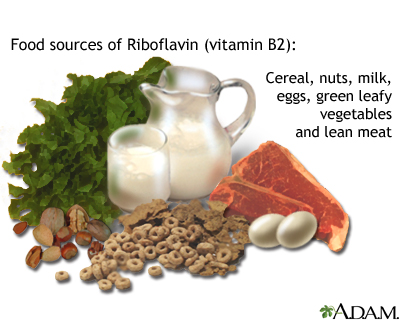Pregnancy SmartSiteTM
Vitamin B2 DefinitionRiboflavin is a type of B vitamin. It is water soluble, which means it is not stored in the body. Water-soluble vitamins dissolve in water. Leftover amounts of the vitamin leave the body through the urine. The body keeps a small reserve of these vitamins. They have to be taken on a regular basis to maintain the reserve. FunctionRiboflavin (vitamin B2) works with the other B vitamins. It is important for body growth. It helps in red blood cell production. It also aids in the release of energy from proteins. Food SourcesThe following foods provide riboflavin in the diet:
Breads and cereals are often fortified with riboflavin. Fortified means the vitamin has been added to the food. Riboflavin is destroyed by exposure to light. Foods with riboflavin should not be stored in clear containers that are exposed to light. Side EffectsLack of riboflavin is not common in the United States because this vitamin is plentiful in the food supply. Symptoms of a severe deficiency include:
Because riboflavin is a water-soluble vitamin, leftover amounts leave the body through the urine. There is no known poisoning from riboflavin. RecommendationsRecommendations for riboflavin, as well as other nutrients, are provided in the Dietary Reference Intakes (DRIs) developed by the Food and Nutrition Board at the National Academies of Sciences, Engineering, and Medicine. DRI is a term for a set of reference intakes that are used to plan and assess the nutrient intakes of healthy people. These values, which vary by age and sex, include: Recommended Dietary Allowance (RDA): The average daily level of intake that is enough to meet the nutrient needs of nearly all (97% to 98%) healthy people. An RDA is an intake level based on scientific research evidence. Adequate Intake (AI): This level is established when there is not enough scientific research evidence to develop an RDA. It is set at a level that is thought to ensure enough nutrition. Dietary Reference Intakes for riboflavin: Infants
*Adequate Intake (AI) Children
Adolescents and adults
The best way to get the daily requirement of essential vitamins is to eat a balanced diet that contains a variety of foods. ReferencesMaqbool A, Parks EP, Shaikhkhalil A, Panganiban J, Mitchell JA, Stallings VA. Nutritional requirements. In: Kliegman RM, St. Geme JW, Blum NJ, Shah SS, Tasker RC, Wilson KM, eds. Nelson Textbook of Pediatrics. 21st ed. Philadelphia, PA: Elsevier; 2020:chap 55. Markell M, Siddiqi HA. Vitamins and trace elements. In: McPherson RA, Pincus MR, eds. Henry's Clinical Diagnosis and Management by Laboratory Methods. 24th ed. Philadelphia, PA: Elsevier; 2022:chap 27. Mason JB, Booth SL. Vitamins, trace minerals, and other micronutrients. In: Goldman L, Schafer AI, eds. Goldman-Cecil Medicine. 26th ed. Philadelphia, PA: Elsevier; 2020:chap 205. National Institutes of Health website. Riboflavin: fact sheet for health professionals. ods.od.nih.gov/factsheets/Riboflavin-HealthProfessional/. Updated May 11, 2022. Accessed February 21, 2023. | |
| |
Review Date: 1/19/2023 Reviewed By: Stefania Manetti, RD/N, CDCES, RYT200, My Vita Sana LLC - Nourish and heal through food, San Jose, CA. Review provided by VeriMed Healthcare Network. Also reviewed by David C. Dugdale, MD, Medical Director, Brenda Conaway, Editorial Director, and the A.D.A.M. Editorial team. The information provided herein should not be used during any medical emergency or for the diagnosis or treatment of any medical condition. A licensed medical professional should be consulted for diagnosis and treatment of any and all medical conditions. Links to other sites are provided for information only -- they do not constitute endorsements of those other sites. No warranty of any kind, either expressed or implied, is made as to the accuracy, reliability, timeliness, or correctness of any translations made by a third-party service of the information provided herein into any other language. © 1997- A.D.A.M., a business unit of Ebix, Inc. Any duplication or distribution of the information contained herein is strictly prohibited. | |

 Vitamin B2 benefit
Vitamin B2 benefit Vitamin B2 source
Vitamin B2 source
